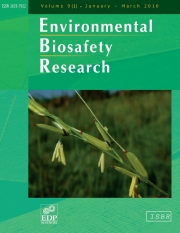Article contents
Bt crops: Predicting effects of escaped transgeneson the fitness of wild plants and their herbivores
Published online by Cambridge University Press: 15 January 2004
Abstract
One prominent concern about genetically modified crops is the possibility of environmental impacts from the movement of fitness-enhancing traits to wild plant populations. Decisions to deregulate Bt crops in the USA have relied strongly on arguments that these crops will not interbreed with wild relatives in the permitted growing regions. Limited attention therefore has been directed to analyses of the consequences of gene flow. To provide a transparent evaluation process for risks associated with insecticidal transgene escape, we crafted a series of questions designed to guide this aspect of the risk assessment. We then explored the current knowledge base available for answering such risk-related questions for three Bt crops (cotton, rapeseed, and rice). First, we generated a list of wild relatives of these crops. A definitive list of potential transgene recipients is not yet possible for some crops. Sufficient data are not available for some crops to eliminate certain related plant species from consideration of fertile hybrid formation, thus making lists for these crops subject to speculation. Second, we queried the HOSTS database (UK) to obtain a worldwide listing of lepidopteran species that feed on these crops and their wild relatives, and to determine the host range of the larvae. To our knowledge, this list of 502 lepidopteran species is the first such list published for these crops and wild crop relatives. Third, we used a data set maintained by the Canadian Forest Service to assess Bt toxin susceptibility for these lepidopterans. Only 3% of those species have been tested for susceptibility; and the literature suggests that generalizations about susceptibility among taxa are difficult due to the variability within families. Fourth, we consulted the literature to interpret what is known about the ability of lepidopterans to regulate plant fitness or invasiveness. We could not eliminate the possibility of ecological release due to plant resistance against lepidopterans. In fact, there is strong experimental evidence that lepidopteran herbivores do limit the distribution and/or abundances of at least some wild plant species. Neither could we eliminate the possibility that non-target lepidopterans might have important functions in the ecosystem as pollinators or alternate hosts to natural enemies of pest species. This study suggests that crucial data are lacking for the development of a credible scientific basis to confirm or deny environmental risks associated with the escape of Bt transgene constructs to wild relatives. Given the absence of information on the identity, level of susceptibility, and ecological roles of lepidopterans exploiting specific wild relatives of Bt crops, we suggest that new efforts be directed to assessing possible consequences of lepidopteran mortality on resistant wild relatives.
Keywords
- Type
- Research Article
- Information
- Copyright
- © ISBR, EDP Sciences, 2003
References
- 16
- Cited by


